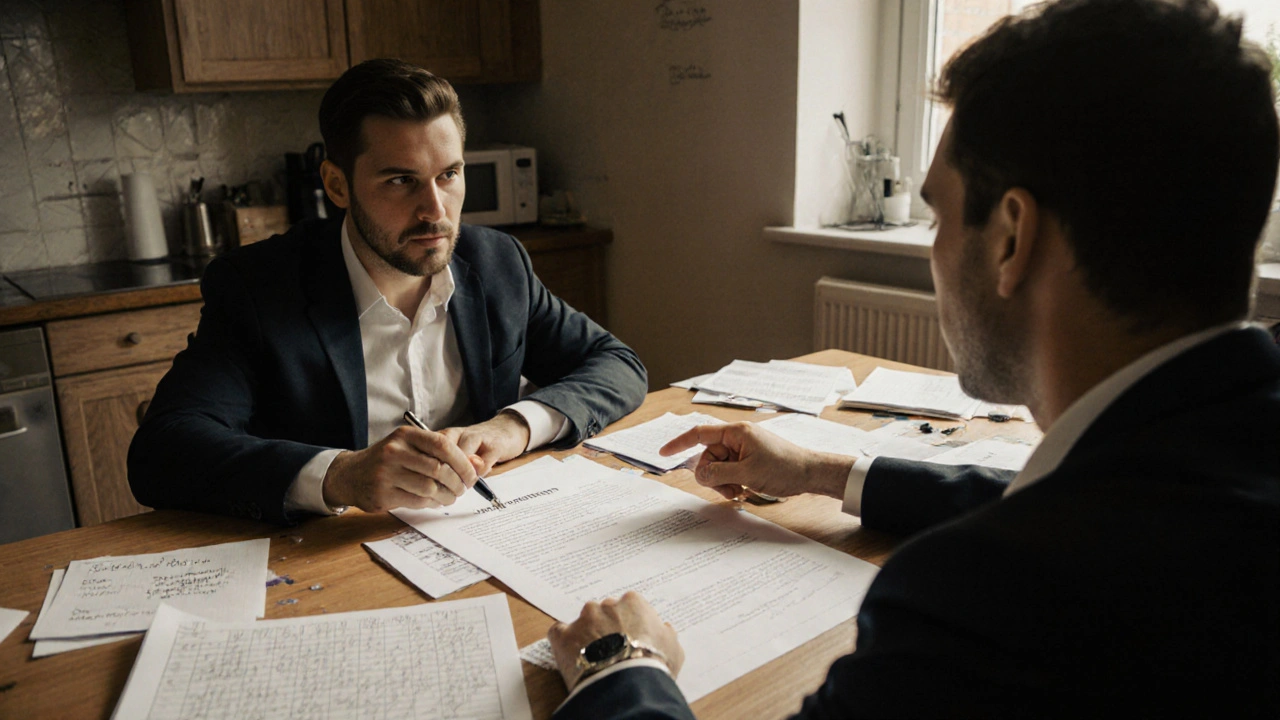Partnership vs Sole Trader in the UK: Which Business Structure Fits Your Goals?
20 Oct, 2025Choosing the right business structure in the UK isn’t just about paperwork-it’s about how much control you want, how much risk you’re willing to take, and how you plan to grow. If you’re deciding between being a sole trader or forming a partnership, you’re not just picking a tax category. You’re choosing your future as a business owner. And the difference between these two isn’t subtle. One leaves you exposed. The other shares the burden-but also the control.
What Does Being a Sole Trader Mean in the UK?
Being a sole trader means you are the business. There’s no legal separation between you and your company. If you run a freelance graphic design service, fix cars in your garage, or sell handmade candles online, and you haven’t registered a limited company, you’re a sole trader by default.
You don’t need to register with Companies House. You just need to tell HMRC you’re self-employed, usually within three months of starting. You file a Self Assessment tax return every year. You pay Income Tax on your profits and Class 2 and Class 4 National Insurance contributions. For the 2025/26 tax year, the personal allowance is £12,570. You only pay tax on what you earn above that.
The upside? Total control. You make every decision-what to charge, who to hire, when to take time off. Setup is cheap and fast. There’s no need for formal agreements or shareholder meetings. You keep all the profits after tax.
The downside? Unlimited liability. If your business owes £50,000 in debts, creditors can come after your home, your car, your savings. No protection. Also, raising money is hard. Banks won’t lend to a sole trader the same way they lend to a limited company. Investors won’t buy shares because there are none to buy.
What Is a Partnership in the UK?
A partnership is when two or more people run a business together. It’s not a separate legal entity either. Like a sole trader, the partners are personally liable for the business’s debts. But now, that liability is shared.
There are two main types: general partnerships and limited partnerships. Most small businesses use general partnerships. You don’t need to register with Companies House unless you’re a limited partnership. But you must register with HMRC as a partnership and file a Partnership Tax Return. Each partner also files their own Self Assessment, reporting their share of the profits.
Many partnerships operate without a written agreement. That’s a mistake. Without one, the Partnership Act 1890 kicks in-and it’s outdated. Under that law, profits are split equally, even if one person put in 80% of the work. Decisions need unanimous consent. And if someone leaves or dies, the partnership dissolves automatically.
A good partnership agreement fixes this. It says who owns what percentage, how profits are split, how decisions are made, what happens if someone wants out, and how to handle disputes. It’s not glamorous, but it’s essential.
Liability: Who Pays When Things Go Wrong?
This is where the two structures split wide open.
As a sole trader, you’re on your own. If a client sues you for a faulty product or you can’t pay your supplier, your personal assets are at risk. Your savings, your house, your pension-none are safe. In 2024, over 12,000 sole traders in the UK faced bankruptcy due to business debts, according to the Insolvency Service.
In a partnership, the risk is shared-but it’s still personal. Each partner is jointly and severally liable. That means if your partner messes up and the business owes £100,000, the creditor can come after you for the full amount. You can then try to recover from your partner, but that’s a lawsuit, not a guarantee.
There’s no shield. No limited liability. If you want protection, you need a limited company. But if you’re just starting and can’t afford the complexity of incorporation, both sole trader and partnership leave you exposed. That’s not a flaw in the system-it’s the reality.
Control and Decision-Making
As a sole trader, you don’t need to consult anyone. You can change your pricing at midnight. You can hire your cousin. You can close up for a week to go surfing. No approvals needed.
In a partnership, everything becomes a conversation. Even small decisions. If you and your partner disagree on whether to spend £3,000 on new equipment, you’re stuck. Without a clear agreement, you might need to vote. Or worse-walk away.
Most partnerships fail not because of money, but because of misaligned expectations. One partner wants to scale fast. The other wants to keep it small and steady. One works 60 hours a week. The other only 30. Without a written agreement, these differences turn into resentment.
A partnership can double your capacity. Two people can handle twice the clients. But it also doubles the chances of conflict. You need trust, communication, and a clear contract-not just a handshake.

Tax and Accounting: What’s Easier?
Both structures use Self Assessment. You report your profits on the same form. You pay the same taxes. There’s no difference in tax rates between a sole trader and a partner. The only difference is how the profits are divided.
For a sole trader, you report 100% of the profit. For a partnership, each partner reports their share. If you own 60% of the business, you pay tax on 60% of the profit.
Accounting is slightly more complex for partnerships. You need to prepare a Partnership Tax Return (form SA800) and give each partner a share of profits statement (form SA800S). But HMRC’s online system makes this manageable.
Neither structure requires audited accounts. You don’t need to file annual reports with Companies House. That keeps costs low. But if you’re making over £85,000 in turnover, you must register for VAT-no matter which structure you choose.
When to Choose Sole Trader
- You’re testing an idea and don’t want to commit long-term
- You work alone and don’t plan to bring in partners
- You’re in a low-risk industry-consulting, writing, tutoring, art
- You want full control and simplicity
- You’re earning under £50,000 a year and don’t need external funding
Many freelancers start as sole traders. It’s the default. It’s easy. It’s cheap. And if your business stays small, it’s perfectly fine.
When to Choose a Partnership
- You have a trusted co-founder with complementary skills
- You need more capital or time than one person can provide
- You’re in a service-based business like accounting, law, or design
- You want to share the workload and stress
- You’ve already signed a written partnership agreement
Partnerships work best when roles are clear. One handles sales. The other handles operations. One brings clients. The other delivers the work. That balance makes the business stronger than either person alone.

What Most People Miss
Many people think the choice between sole trader and partnership is final. It’s not. You can change. Many sole traders start alone, then bring in a partner later. That’s fine-but you need to dissolve the sole trader business and form a new partnership. HMRC needs to be notified. Bank accounts need to be closed and reopened. Contracts need to be reassigned.
Similarly, if you’re in a partnership and one partner wants out, you can’t just kick them out. You need to follow the terms of your agreement-or go to court. That’s expensive and messy.
The biggest mistake? Waiting until things go wrong to talk about what happens if they do. Don’t wait. Talk now. Write it down. Sign it.
What Comes Next?
If you’re serious about growing beyond £100,000 in revenue, or if you want to attract investors, or if you want to protect your home from business debt-you’ll eventually need a limited company. It costs more. It’s more paperwork. But it gives you limited liability. Your personal assets stay safe.
But if you’re just starting out, or if you’re happy keeping it small, sole trader or partnership are both valid. Neither is wrong. It’s about matching the structure to your life, your risk tolerance, and your goals.
Ask yourself: Do I want to do this alone? Or do I want someone to share the load-with the good and the bad?
Can I start as a sole trader and later turn it into a partnership?
Yes. You can start as a sole trader and later bring in a partner. But you can’t just add a partner to your existing sole trader business. You need to close the sole trader setup and form a new partnership. This means notifying HMRC, opening a new bank account in the partnership’s name, and updating any contracts or licenses. You’ll need to file a final Self Assessment as a sole trader, then register the partnership with HMRC and file a Partnership Tax Return going forward.
Do I need a written partnership agreement?
You’re not legally required to have one, but you absolutely should. Without it, the Partnership Act 1890 governs your business-and it’s outdated. Under that law, profits are split equally, no partner can be paid a salary, and the partnership ends if someone dies or leaves. A written agreement lets you set your own rules: profit shares, decision-making, exit plans, and dispute resolution. It’s the best way to avoid a costly breakup.
Is a partnership better for tax than a sole trader?
No. There’s no tax advantage between the two. Both pay Income Tax and National Insurance on profits. The only difference is how the profit is divided. If you’re a partner, you pay tax only on your share. But your tax rate is the same as if you were a sole trader earning that same amount. The structure doesn’t lower your tax bill-it just changes who reports what.
Can a partnership have more than two people?
Yes. A general partnership can have any number of partners-two, five, or even ten. Each partner must be named in the partnership agreement and registered with HMRC. Each also files their own Self Assessment and pays tax on their share of the profits. More partners means more perspectives, but also more complexity in decision-making and communication.
What happens if a partner dies or leaves?
If you don’t have a written agreement, the partnership legally dissolves. The business stops. All assets are sold, debts paid, and remaining money split. If you have an agreement, it should say what happens next: Does the remaining partner buy out the deceased’s share? Is there a valuation method? Is insurance in place to cover the payout? Without these rules, you’re left with uncertainty, legal costs, and possibly the end of your business.
Final Thought: Your Business, Your Risk
There’s no perfect structure. Only the right one for your situation. If you’re risk-averse, value control, and plan to stay small-sole trader makes sense. If you have a strong partner, want to grow faster, and are ready to share control-partnership can be powerful. But neither protects your personal assets. If that matters to you, plan ahead. Talk to an accountant. Consider a limited company. Because in business, the biggest risk isn’t failure. It’s assuming you’ll have time to fix things later.
